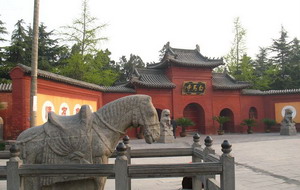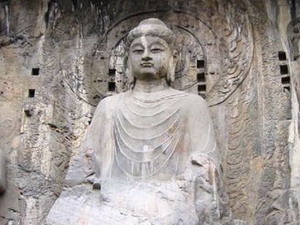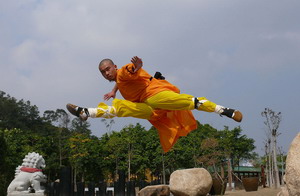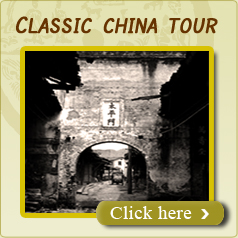White Horse Temple

Located 12.5 km east of Luoyang, White Horse Temple was built in 68 A.D. It is the first Buddhist temple in China since the religion spread to the country.
Therefore it is regarded as the ancestral temple and respectfully called "No.1 Ancient Temple in China".
The story of its founding is that one night, the emperor was said to have dreamed of a deity flying over his palace. The next day he told his minister, and the minister Zhong Hu explained to him that he probably dreamed of Buddha in India. The emperor then sent a delegation of 18 headed by Cai Yin, Qin Jing and Wang Zun to seek Buddhism. They returned from Afghanistan with an image of Gautama Buddha, the Sutra of Forty-two Sections and two eminent monks.
The monk names have been variously romanized as Kasyapamatanga and Dharmavanya, Moton and Chufarlan.
The next year, the emperor ordered the construction of White Horse Temple to remember the horse that carried back the sutras.
Kasyapamatanga and the other Indian monk were buried in the white Horse Temple. After the two eminent monks, many monks from the Western Regions came to Luoyang one after another. In the Tang Dynasty, Xuan Zang (a famous monk in China) went from Luoyang to the Western Regions to go on a pilgrimage for Buddhist scriptures. After returning to the homeland, he became the abbot of White Horse Temple and spread the scriptures of Buddhism. Many halls and statues were found in this monastery, which date back to the Yuan and Ming dynasties (1206-1644 AD).
According to historical records, Emperor Ming of the Eastern Han Dynasty (25 - 220 AD) once sent his minister on a diplomatic mission to western region to learn about Buddhism. After finished study, they came back with two eminent Indian dignitary monks - She Moteng and Zhu Falan, and a white horse carried the sutra and the figure of Buddha. In order to memorialize the white horse's contribution of taking back the sutra, Emperor Ming ordered the construction of the temple and named it White Horse Temple.
White Horse Temple was regarded as the "originating court" and the "cradle of Chinese Buddhism" by the Buddhist disciples. Since its establishment, White Horse Temple has experienced vicissitudes of centuries. It was rebuilt for several times, in which the restoration during the reign of Emperor Wu Zetian was especially notable in its large scale.
Today's White Horse Temple is a rectangle courtyard facing south. The gate of the White Horse Temple was built in Ming Dynasty (1368 - 1644) and it is three arches side by side. Covering a total area of 40, 000 square meters, the temple mainly consists of Tianwang Hall, Great Buddha Hall, Daxiong Hall, Jieyin Hall, Qingliang Terrace and Pilu Pavilion, which are all distributing along the north-south central axis.
Extant are the Hall of Heavenly King Hall, Mahavira Hall, Boddhisattiva Hall, Avalokitesvara Tower, Reception Hall and Vairocana Tower. Two white horses flank the front gate. The big iron bell in Boddhisattiva Hall could be heard from 5km away at a moonlit night. The bell is one of the "Eight Sights of Luoyang".





